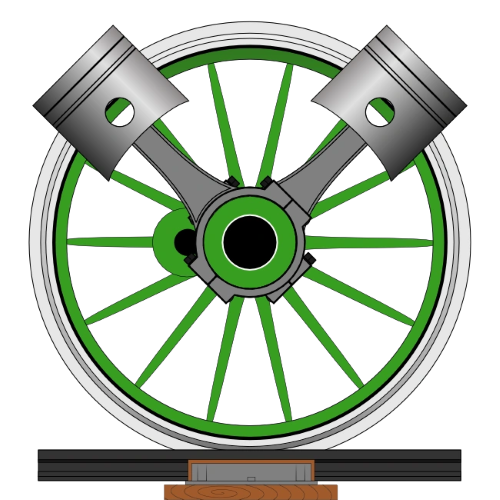The 520 Class is a 4-8-4 "Northern" type steam locomotive that operated on the South Australian Railways from 1943 to 1971
History
During World War 2, the South Australian Railways needed more powerful engines to haul increasingly heavier and longer troop, passenger and supply trains that could haul heavy trains at high speeds and take all but the most heaviest trains up the 19 mile long 1 in 45 gradient up the Adelaide Hills, thus the 520 came into existence, combining the best features of the 620 Class 4-6-2 and 500B Class 4-8-4 engines. They were also streamlined in a similar fashion to the PRR T1 4-4-4-4 engines (although most of the class were semi de-streamlined later in life, namely removing the front guard)
While they were large engines designed for high speed mainline operation and required larger turntables, their axle load was suitable to work on branchlines with 60 lb (36 kg/m) rail, although they had to have their coal and water loads reduced in order to work on them
Shortly after the war due to poor quality coal the class was converted to fire a combination of coal and oil
Preservation
Two 520's survive, each in different streamlining formats
- 520 survives preserved by the South Australian division of the ARHS aka SteamRanger and was restored to operational condition in 1972 and ran until 1998 when mechanical issues (namely in regards to removal of oil burning features) arose and the tender frame was rusted and the engine was put into long term storage due to excessive restoration costs (think, in excess of $300,000) and the only line, the Victor Harbor railway line, currently available for it to run on being far too short for an engine of it's size and power, especially after the Melbourne-Adelaide railway line was converted to standard gauge in 1995. Currently due to private funding restoration of the engine to operational condition has begun
- 523 survives in static preservation in the National Rail Museum at Port Adelaide
Specifications
The 520 Class weighs 204 tonnes and has an axle load of 16.1 tonnes. The boiler has a maximum pressure of 215 psi and the engine itself can produce a tractive effort of 36,600 lbf and power outputs of 2,800 drawbar horsepower. The firebox possesses a grate area of 42 square feet (4.2 m^2). The cylinders are 20.5 inches (521 mm) in bore and 28 inches (711 mm) in stroke. The driving wheels are 66 inches (1.68 m) in diameter
Originally their tenders could carry 9 tons of coal and 9100 gallons (41,000 litres) of water, although they were limited to loads of 5 tons of coal and 8200 gallons of water (37,277 litres) when running on light lines
Trivia
- The 520 was the first engine class in SA, if not Australia to feature an all welded, all steel boiler
- The 520's had several other modern features such as Timken roller bearings on axles (first engine in Australia to have them), one piece steel bar frames, thermic siphons, power reversing gear, self cleaning smokebox and several other modern features
- The 520 was built combining the best of the 620 4-6-2 and the 500B Class 4-8-4
- 520-522 were built with a low streamlined nose compared to 523-532, which had a higher streamlined nose, truly similar to the PRR T1 Duplexes they were based off
- The Commonwealth Railway used the 520 Class as the basis for a proposed 4-8-4 express engine to supplant the C Class 4-6-0's which would run on the Trans-Australian Railway between Port Pirie, (South Australia) and Kalgoorlie (Western Australia). The engine would run on standard gauge tracks of 4' 8.5" (1,435 mm), have 72 inch (1.83 meter) driving wheels, a 16 wheel tender with massively greater coal and water capacity (for running across the Nullabor long distances) ontop of having much larger dimensions. However since the Trans Australian was intended for diesel power since it was first built, the idea fell out in favor of the CM Class diesels in the 1950's, and the preceding steam locomotives were retired and scrapped
- The South Australian Railways also had plans for an enlarged 4-8-4 which was essentially an upsized 520 Class, known as the 800 Class, which would have exceeded the SAR 500B Class 4-8-4 engines in terms of power, becoming the most powerful broad gauge steam engines in Australia (matched by the NSWGR 60 Class 4-8-4+4-8-4 Garratts), however due to dieselisation these plans never eventuated
